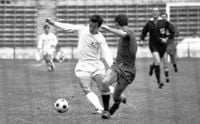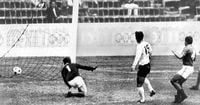The world of football is mourning the loss of one of its true icons, as Kunishige Kamamoto, Japan’s most prolific goalscorer and a towering figure in Asian soccer history, passed away on Sunday, August 10, 2025, at an Osaka hospital due to pneumonia. He was 81 years old. The Japan Football Association confirmed the news, and tributes have poured in from across the footballing landscape, underscoring the immense impact Kamamoto had not only on Japanese soccer but also on the game’s growth throughout Asia.
Kamamoto’s legacy is defined by extraordinary numbers and unforgettable moments. Between 1964 and 1977, he donned the Japan national team jersey 76 times, netting an astonishing 75 goals—a record that stands to this day. His scoring prowess was never more evident than at the 1968 Mexico City Olympics, where he finished as the tournament’s top scorer with seven goals, leading Japan to an unprecedented bronze medal. That Olympic feat remains the nation’s best-ever finish in men’s soccer, a milestone that elevated the sport’s profile across the country and continent.
It is little wonder that the Canadian Broadcasting Corporation, in a 2005 retrospective, declared Kamamoto “unquestionably, the greatest Japanese soccer player of all time.” His legend was further cemented when Brazilian superstar Pele, himself a global icon, described Kamamoto as “a great striker.” Such praise from football royalty speaks volumes about the Kyoto native’s reputation on the world stage.
Kamamoto’s club career was equally remarkable. He spent his entire professional journey with Yanmar Diesel Soccer Club—now known as Cerezo Osaka—in the Japan Soccer League from 1967 to 1984. His 251 league appearances yielded a staggering 202 goals, and he led the league in scoring on seven occasions. Kamamoto was named to the JSL’s Best XI team an astonishing 14 times, a testament to his consistent excellence and dominance in Japanese football. In cup competitions, he was just as lethal, scoring 51 goals in 48 Emperor’s Cup matches.
His list of accolades is lengthy and impressive: seven-time Japanese Football Player of the Year, first-ever inductee into the Japan Football Hall of Fame in 2005, and recipient of the prestigious Order of the Rising Sun, Gold Rays with Neck Ribbon in 2014 for his contributions to soccer and society. Kamamoto’s influence extended beyond the pitch. From 1978 to 1984, he served as player-manager for Yanmar Diesel, and he later managed Matsushita Electric (which became Gamba Osaka) from 1991 to 1994, guiding the club through the transition into the professional J.League era.
His leadership was not confined to the technical area. Kamamoto was vice president of the Japan Football Association from 1998 to 2008, a period that saw Japanese soccer reach new heights, including its first qualification for the FIFA World Cup in 1998 and co-hosting the tournament with South Korea in 2002. As a member of the Liberal Democratic Party, he also served in the House of Councillors from 1995 to 2001, further demonstrating his commitment to public service and the development of football in Japan.
The outpouring of tributes since Kamamoto’s passing has been heartfelt and widespread. Asian Football Confederation President Shaikh Salman bin Ebrahim Al Khalifa called Kamamoto “a true icon of Asian football whose achievements will forever be remembered.” In a statement posted on the AFC website, Shaikh Salman added, “His role in leading Japan to the bronze medal at the 1968 Olympic Games inspired generations and elevated the profile of the beautiful game across the continent.” He extended condolences to Kamamoto’s family, friends, and the Japan Football Association, emphasizing that “his legacy will continue to inspire and his contribution to the game will never be forgotten.”
Japan Football Association President Tsuneyasu Miyamoto echoed those sentiments, stating, “Mr Kamamoto was truly an unparalleled striker.” J.League chairman Yoshikazu Nonomura reflected on Kamamoto’s influence, saying, “Kamamoto’s presence as a player and coach has played a major role in shaping the soccer world as we know it today. I would like to continue to develop the soccer world that he helped build.”
Even among his peers, Kamamoto’s technical excellence was legendary. Kenzo Yokoyama, the goalkeeper who played alongside him at the Mexico City Olympics, remembered, “He always emphasized how important it was to stop the ball before shooting, and he practiced that technique extensively. I was also trained by receiving hundreds of his shots.”
Hajime Moriyasu, current manager of the Samurai Blue, highlighted Kamamoto’s broader impact: “He gave us a ray of hope that Japanese football can compete on the international stage. I’m hoping for a player who could eventually eclipse Mr Kamamoto to emerge.” Kozo Tashima, honorary president of the JFA, delivered a moving eulogy at Kamamoto’s funeral in Osaka, attended by approximately 170 people. “Looking back on the long history of Japanese soccer, unfortunately there is no other striker who can compete on equal terms with the world,” Tashima said, according to NHK. “There was no one who loved soccer and the Japanese national team as much as he did. I want to carry on that spirit and fully support the players and coaches at next year’s [FIFA] World Cup.”
Kamamoto’s roots in the game ran deep. Born in Kyoto’s Ukyo Ward on April 15, 1944, he attended Yamashiro High School before starring at Waseda University, where he was the Kanto University League’s top scorer for four straight seasons. His passion for nurturing the next generation was evident in his commitment to grassroots development—he conducted more than 1,200 soccer clinics throughout Japan, according to Kyodo News.
One of the most memorable moments of his career came in September 1977, when the star-studded New York Cosmos, led by Pele and Giorgio Chinaglia, faced the Japan national team in Tokyo. Though the Cosmos won 3-1 before 65,000 fans, Kamamoto received an unforgettable gift: Pele’s spiked shoes from the match—a symbol of mutual respect between two greats of the game.
Kamamoto’s story is one of relentless excellence, national pride, and a lifelong dedication to the sport he loved. His thunderous shot, quick movement, and killer instinct for goals inspired countless young players. As described in a “Timeless Legends” YouTube tribute, “Inspired by Portugal’s legendary Eusebio, a thunderous shot, quick movement and a killer instinct for goals—he had it all.”
As Japan prepares for future challenges on the international stage, the memory of Kunishige Kamamoto’s achievements and spirit will remain a guiding light. His legacy endures not just in record books or medals, but in the hearts and ambitions of those who dream of following in his footsteps. The football world bids farewell to a legend, but his influence will echo for generations.



